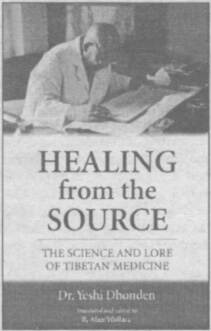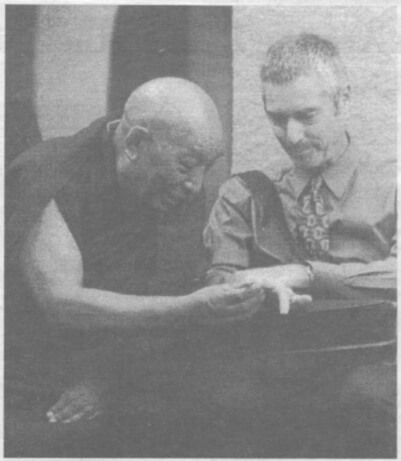| The following article is from the Spring, 1950 issue of the Snow Lion Newsletter and is for historical reference only. You can see this in context of the original newsletter here. |
The Science and Lore of Tibetan Medicine

by Dr. Yeshi Dhonden translated and edited by B. Alan Wallace
214 pages, #HEFRSO $16.95 Available Now!
Review by Glenn H. Mullin
In 1642 the great Fifth Dalai Lama became spiritual and temporal head of a newly formed Tibetan nation. A few years later he established the Mentsikhang, or Medical Academy, on Iron Mountain in Lhasa. Prior to this era the traditional healing arts of Tibet had largely been passed through privately owned clinics and hospitals, usually run as small family enterprises, and with medical knowledge being passed from parents to children.
From the time of the Fifth Dalai Lama until the Chinese takeover of Tibet forty years ago the Mentsikhang served as the most important medical school in the country, dedicated to training young doctors in the traditional healing arts. It quickly developed into the basis of a national medicare system; student doctors would come from all over Central Asia, train for a dozen or so years, and then return to their homelands, where they would operate a small clinic for the people. Within a few decades the network of facilities born from the activities of Lhasa's Medical Academy extended to Tibet's furthermost borders and beyond. Family clinics continued to offer training programs for aspiring young doctors, as well as offer medical care to the sick, but the prestige of the Mentsikhang soon eclipsed them all. A graduate degree from the Mentsikhang was held in a higher stead than one from any other institution.
Dr. Yeshi Dhonden, whose transcribed lectures form the body of Healing from the Source (subtitled The Science and Lore of Tibetan Medicine) is one of the few doctors trained in Lhasa's Mentsikhang to escape into India after the Chinese crackdown of 1959. He therefore was regarded by the Tibetan refugees in India as an embodiment of the highest knowledge of traditional Tibetan medicine. Consequently in the early 1960s when His Holiness the present Dalai Lama wanted to establish a Tibetan Medical Academy in exile, he turned to Dr. Yeshi Dhonden. Dr. Dhonden helped establish this important institution, and also served as the Dalai Lama's private physician for almost twenty years. Some readers will be familiar with his name; his earlier book with Snow Lion Publications, Health Through Balance, has become something of a primer on Tibetan medicine; and also the spin-offs from his various lecture tours in Europe and Americaappearances in several documentary films and television specials, as well as interviews published in newspapers, magazines and scholarly journals (one such article even finding its way onto the pages of Reader's Digest)have made him something of an ambassador not only of Tibetan medicine but also of the Tibetan people in general.
As Dr. Dhonden points out in Healing from the Source, the Tibetans consider the historical Buddha to be the ultimate source of the Tibetan medical system. The earliest Tibetan medical texts are said to be translations of Indian Sanskrit works. Readers therefore will notice a distinct similarity between the language of Tibetan medicine and that of Indian ayurveda, the traditional healing system of India. Dr. Dhonden states, as do all Tibetan texts, that the Buddha taught ayurveda (perhaps best translated as knowledge of life) when he expounded The Ambrosial Heart Tantra for Healing. The rest of the Indians (i.e., the Hindus, Jains, etc.) acquired the system from later Buddhist monk doctors.

Dr. Yeshi Dhonden with B. Alan Wallace (photo by Sony a Sones)
This is a refreshing and challenging assertion; Indian ayurveda today as well as most Western academics would have us believe that the cross-fertilization went the other way, i.e., that the Buddhists borrowed the ayurveda system from the Hindus. If Dr. Dhonden is right, the probable scenario is that the Hindus borrowed ayurveda from the Buddhists somewhere in the third century BCE, when the Buddhist king Ashoka ruled an empire that covered all of north India and modern-day Pakistan, from the bay of Bengal to the foothills of Afghanistan. King Ashoka spent a large portion of the national surplus on building and maintaining not only Buddhist temples and monuments, but also hospitals, health care and rest centers along remote highways, and educational institutions, including those dedicated to the training of young doctors. Modern day India uses one of the heads from a pillar created by Ashoka as its national emblem; this appears on coins and paper currency, as well as on stamps and seals, bearing testament to the impact that his rule had on Indian history.
Tibetan medicine also shows some similarities with traditional Chinese medicine. Dr. Dhonden states that this came about as a result of the high status given to Tibetan doctors during the Mongolian and Manchurian rulerships of China. Known respectively as the Yuan and Ching Dynasties, the emperors who ruled much of the Far East during these periods were largely Tibetan Buddhist by spiritual persuasion, and kept Tibetan doctors in their courts, as did much of their aristocracy. Marco Polo, the thirteenth-century Italian adventurer who stayed in the court of the Yuan emperor Kublai Khan for some months, mentions how well the emperor treated the Tibetans in his court.
Because of the similarities between Tibetan medicine and the medical traditions of India and China, Healing from the Source will be fairly easy reading for anyone familiar with either of these two systems. Newcomers to the Asian healing arts will perhaps have to make more of an effort to penetrate the material. The lectures on which the book is based were delivered to a group of health care professionals at the California Pacific Medical Center in San Francisco, and thus don't presume specialized knowledge of oriental medicine. There is therefore much in Healing from the Source that will be of interest to the general reader. Dr. Dhonden's frank discussion of his work with cancer and AIDS patients, and of Tibetan medical ideas on the treatment of these and other modern afflictions, provides considerable food for thought. His presentation of the fundamental principles of Tibetan medicine is succinct and clear. In addition, Dr. Dhonden packs his discussion with anecdotes from his own medical training and practice, thus providing a glimpse into the world of Tibetan medicine as a living tradition. ä_æ

